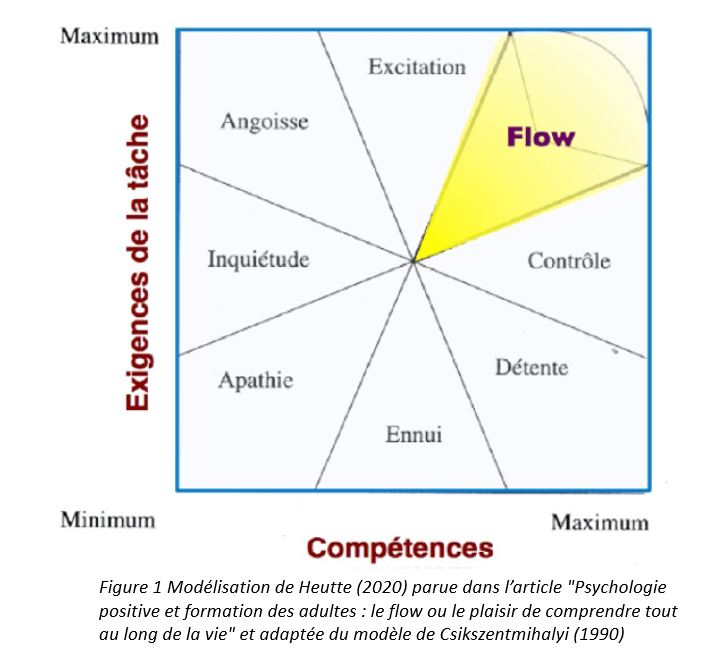What if training was a source of well-being? The flow phenomenon
Have you ever been so absorbed in an activity that you felt as if time had stopped? Have you ever been so focused that you forgot all your problems? Have you ever felt that everything was easy, that everything was under control? Have you ever been in such a state of completeness that you merged with your activity? If you answered yes to these questions, you have experienced the state of flow.
Flow is an experience of optimal well-being
Flow is an experience of optimal well-being that is lived solely for its own sake, i.e. with no other goal than its realisation and the pleasure that comes from it (this is the definition of an autotelic experience). Flow is the emotion experienced when a person feels fulfilled, mentally fluid, totally focused and in complete control. It is also characterised by such a sense of closeness to the goal that one is confident of achieving it. This closeness promotes commitment and encourages one to continue in the activity.
Positive psychology is the fourth trend in psychology and the most recent (founded in 1998). It studies the well-being and optimal development of people thanks to their strengths, their virtues, their resources. It is interested in the development of people’s abilities, their fulfilment, their reciprocity, their resilience, their benevolence, their cooperation…
The study of flow began in the 1970s. The first studies concerned sportsmen and women and their emotions during competitions which guaranteed the success of their objectives. People who do a sport activity for the pleasure it gives them are very likely to experience flow often. Conversely, those who do sport because of societal injunctions are unlikely to experience it, unless their motivation for doing sport changes to be more intrinsic. Teaching and the arts are also areas where experiencing flow is common. The concept was theorised by Csikszentmihalyi, a very influential Hungarian psychologist and one of the two founders of the positive psychology movement. The first model dates from 1975 and the last from 1990.

Vertical axis: Requirements for the task
Horizontal axis: Ability
- Excitement
- Flow
- Control
- Relaxation
- Boredom
- Apathy
- Uneasiness
- Anguish
Figure 1 is the modelling of Heutte (2020) appearing in the article ‘Postive psychology and training of adults : flow or the pleasure of understanding throughout one’s life’ and adapted from the Csikszentmihalyi model (1990)
Figure 1 is the flow model of Heutte (2020) adapted from Csikszentmihalyi (1990).
It consists of two axes: challenge and skills. It is possible to experience flow when challenge and skill are at their highest. It is a balance between the level of demand of a task and the skills of a person in doing something difficult and important. If a person’s skills are high but the challenge is low, they will be relaxed. Conversely, if the challenge is very demanding and exceeds low skills in a domain, he or she will be anxious.
Why does the state of flow engross us and change our perception of time?
A demanding challenge requires the mobilisation of all our skills. To do this, it is essential to focus all our attentional resources on the activity. This attentional tunnel ignores all distractions in our environment and changes our perception of time: it is complete focus. The time for carrying out the activity, the environment and time takes a back seat. It is the performance of the activity and the proximity of the goal that take precedence.
Why are we interested in flow in training?
Nowadays, one of the greatest challenges in training is to set up teaching methods that interest learners enough to sustain their efforts in their training courses. The aim is to get the learner to self-train and enjoy their training. The more the training intention comes from the learner himself and not from external constraints, the more sustainable it is. However, it is impossible to encourage motivation in the learner directly. So motivational variables come into play and have a positive or negative impact on motivation. Flow is one of these motivational variables which has a positive impact on motivation.
A recent study (Heutte, 2020) reviews the work done on flow. It shows that it is a major determinant of behavioural persistence, particularly when it has already been experienced in the activity. This means that experiencing flow in an activity increases the chances of experiencing flow in future activities.
Flow has multiple effects and helps to make training more enjoyable and richer. This experience is accompanied by better performance, a leap in creativity, capacity building, self-esteem and stress reduction.
Flow, through the perception of control over the activity it provides, also meets the need for competence: it is the feeling of mastery and efficiency. The need for competence is a universal psychological need that satisfies intrinsic motivation, the one that allows us to perform tasks out of interest and without external pressure. It is the most powerful type of motivation.
How to promote flow in training?
There are several ways to promote flow in training:
– Set clear objectives: it is when we know where we are going that we can start.
– Adapt the objectives to the level of the learners: knowing your learners allows you to offer them challenges that match their skills, so that they do not feel anxious if the challenge is too big or bored if the challenge is too easy
– Benefit from feedback, clear and precise feedback: feedback allows us to know if we are heading in the right direction and not to interrupt the state of flow. Indeed, if a difficulty appears too great for the person and he/she does not receive help to remove this blockage, the state of flow is interrupted.
– Gamifying training means adding game elements and mechanics to make it more engaging and motivating. The educational escape game is an example of this.
Flow is an interesting lever that links cognitive functioning and the “pleasure circuits” (Changeux, 1994). This connection associates a controlled cognitive effort with a feeling of fulfilment and of optimal development. It is an autotelic experience which, when applied to training, is intended to create a desire in learners to return to training.
Camille Besson, in charge of the Learner Experience project.







